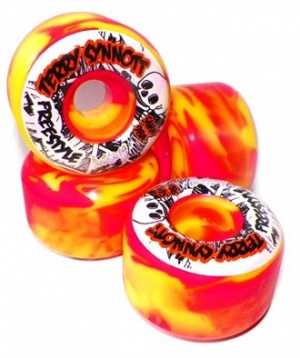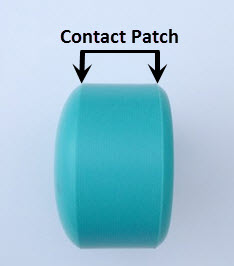Wheels
Modern skateboard wheels are made out of polyurethane and come in a variety of sizes, colors, durometers and smells. There are many factors that determine the performance of a wheel, but the two main factors are the diameter and durometer.

- Diameter (Size)
- The diameter is the height of a wheel measured (in millimeters) from top to bottom. Smaller wheels will be lighter and accelerate faster, but they are slower and don't retain speed as well. Larger wheels are faster and retain speed better, but they are heavier and accelerate slower. By far, the most common diameters for freestyle are 54-55 mm (55 mm being the most common). Browse Wheels by Diameter for more options.
- Durometer
- The durometer is a measure of hardness of a material and refers to the hardness of a wheel. The wheels are usually rated with a number, followed by an "A" to tell you how hard the wheels are. The lower the number, the softer the wheel. And the higher the number, the harder the wheel. Most freestyle wheels tend to be 98A and is a good duro for most surfaces. For rougher surfaces a softer wheel, like a 95A, will make your ride a lot smoother and you'll still be able to break free for shove-its and such. Softer wheels will also grip the ground better, but they also develop flatspots easier. Harder wheels will last you longer, but don't grip as much. There are pros and cons to both, so you just have to experiment to find the right wheel for you.
- By far, the most common Durometer for freestyle is 98A (95A being second). Browse Wheels by Durometer for more options.
- Cores
- A wheel with a hard plastic core will have better bearing alignment and roll smoother. And deep offset cores are a must if you are going to be doing any amount of Rail Tricks.
- Contact Patch
 Contact patch of a MODE 99A Freestyle Wheel
Contact patch of a MODE 99A Freestyle Wheel
A Contact Patch is the area of the wheel that actually makes contact with the ground. Freestyle wheels traditionally have a wider contact patch than street wheels because wider offset wheels are necessary for protecting the axle and providing stability for Rail Tricks. A wheel with a wider Contact Patch may feel a little sluggish, but also very stable. A narrower Contact Patch will be more responsive and quicker turning than a wider one, so former street skaters may feel more comfortable with these.
Freestyle Wheels
One of the most important features for freestyle use (especially for Rail Tricks and Coconut Wheelies) is an offset core. A deep offset core is one of the primary features that differentiates a freestyle wheel from an average street wheel. When centerset (non-offset) wheels are used for Railstands, your axle and axle nuts will be exposed, making direct contact with the pavement. This makes for an unstable platform (in rail) and will damage your axles (and the pavement).
Axle to pavement contact in rail with typical centerset street wheels on a street board |
Axle damage from Rail Tricks without axle-protecting deep offset wheels |
When proper deep offset wheels are used, the axle is recessed and protected from damage. This also widens the contact area, or footprint, and creates a much more stable rail platform.
Recessed axle and nut with offset Seismic Focus 97A Wheels |
Deep offset Seismic Focus 97A Wheels shown flush with the pavement. |
Some wheels may not be deeply offset enough so you may have to use one or more Axle Washers to help push your wheels out, so your axle doesn't stick out. You may also need to adjust where the wheels are in relation to the edge of the deck for best stability in rail. The wheels should never really extend past the edge of the board. Placing the wheels even with the board will help with Rail Whips because it lessens deck drag. Bob Loftin believes the optimal placement should be somewhere around 1/8" to 1/4" narrower than the Deck. It is all a matter of preference, but this range can provide better rail stability. Just try some different settings and see which configuration works best for you.
For a list of currently available deep offset freestyle wheels, see our List of Freestyle Wheels.
Wheel History
The initial invention of the wheel falls into the late Neolithic or Stone Age (around 3500 BC) and basically consists of a circular component that rotates around an axle. With a serious lack of flat surfaces, precision bearings and smooth wheels, early cavemen were restricted to mostly stationary tricks. Some modern freestylers still honor this early primordial style by doing whole sessions on sheets of plywood, on tabletops, on vending machines, in elevators, etc…
In the mid 1900's, there weren't any wheels made exclusively for skateboards so roller skate wheels, made out of wood, steel or clay composite, were used on the early skateboards.
Then in 1973, Frank Nasworthy of Cadillac Wheels created the world's first urethane skateboard wheels. This innovation changed skateboarding forever and greatly increased the potential for the unlimited possibilities we enjoy today.
Today, there is great selection of high-quality freestyle wheels available to us, from great companies like Decomposed, MODE Skateboards, Momentum Wheel Company, Moska Wheels, Never Enough Skateboards, Seismic Skate Inc., Skull Skates and Sk8Kings.
For a list of currently available deep offset freestyle wheels, see our List of Freestyle Wheels.